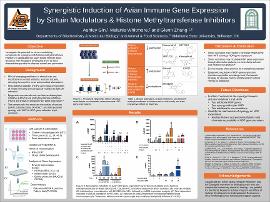| dc.contributor.advisor | Zhang, Glenn | |
| dc.contributor.author | Gin, Ashley | |
| dc.contributor.author | Whitmore, Melanie | |
| dc.date.accessioned | 2022-05-13T13:02:42Z | |
| dc.date.available | 2022-05-13T13:02:42Z | |
| dc.date.issued | 2022-04-15 | |
| dc.identifier | oksd_Wentz_2022_gin | |
| dc.identifier.citation | Gin, A., Whitmore, M., & Zhang, G. (2022, April 15). Synergistic induction of avian immune gene expression by sirtuin modulators and histone methyltransferase inhibitors. Poster session presented at the Oklahoma State University Wentz Research Scholars Symposium, Stillwater, OK. | |
| dc.identifier.uri | https://hdl.handle.net/11244/335704 | |
| dc.description.abstract | With the parallel increase in the global demand for poultry production and rise in the threat of antimicrobial resistance, the development of novel antibiotic alternatives is integral to the security of the food-animal industry and public health. Recently, the induction of host defense peptides (HDPs) of the innate immune system has emerged as a host-directed therapeutic approach to simultaneously mitigate poultry infections and disease resistance. This study is focused on comparing the capacity for several epigenetic compounds, specifically four sirtuin modulators and a known histone methyltransferase inhibitor (BIX01294), to induce the avian innate immune response. To evaluate the in vitro response, chicken macrophage cells were treated with each compound (resveratrol, SRT2104, sirtinol, and EX527) with or without BIX01294 at variable timepoints (12, 24, 48 h). Following optimized treatment, RNA isolation, reverse transcription, and qPCR analysis of select innate immune genes (AvBD3, AvBD9, AvBD10, CLDN1, IL-1B, and MUC2) were performed to profile the avian immune response. Despite the hypothesized upregulation of the innate response strictly from sirtuin inhibitors, both the sirtuin inhibitors and activators synergized with BIX01294 to induce a significant avian HDP response with minimized inflammation. Although no further expression of mucosal or tight junction barrier protective genes was induced by any of the four modulators, this study furthers the need to understand sirtuin modulator epigenetic activity with future studies of histone profiling. Despite the unknown mechanisms of sirtuin modulators, the significant synergy response to these treatments validates the promising potential for these compounds to be actively explored as antibiotic alternatives. | |
| dc.description.sponsorship | Lew Wentz Foundation | |
| dc.format | application/pdf | |
| dc.language | en_US | |
| dc.publisher | Oklahoma State University | |
| dc.rights | In the Oklahoma State University Library's institutional repository this paper is made available through the open access principles and the terms of agreement/consent between the author(s) and the publisher. The permission policy on the use, reproduction or distribution of the article falls under fair use for educational, scholarship, and research purposes. Contact Digital Resources and Discovery Services at lib-dls@okstate.edu or 405-744-9161 for further information. | |
| dc.title | Synergistic induction of avian immune gene expression by sirtuin modulators and histone methyltransferase inhibitors | |
| osu.filename | oksd_Wentz_2022_gin.pdf | |
| dc.description.department | Biochemistry and Molecular Biology | |
| dc.description.department | Animal and Food Sciences | |
| dc.type.genre | Poster | |
| dc.type.material | Text | |
| dc.type.material | Image | |
| dc.subject.keywords | epigenetics | |
| dc.subject.keywords | sirtuin modulators | |
| dc.subject.keywords | histone modifications | |
| dc.subject.keywords | antibiotic alternatives | |
| dc.subject.keywords | host defense peptides | |
